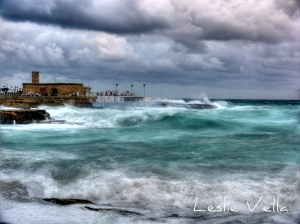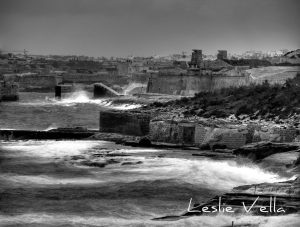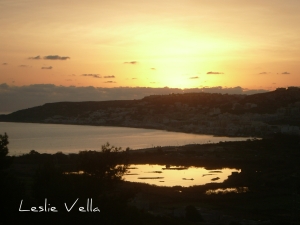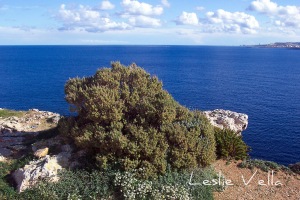 As Yellow as a Crown Daisy
As Yellow as a Crown Daisy
In Malta spring comes early. At a time of the year when the countryside in most European countries is still bare, grey and dormant, the Maltese countryside thrives under the magical combination of rainfall, sunshine and generally mild temperatures. The result: a multi-hued carpet of green that appears in late autumn and explodes into a riot of wild flowers from January until May. Then, in complete contrast to nature on the European continent, the Maltese summer comes, and with it a period of dormant nature which shrivels up and goes underground in reaction to the merciless sun and the total absence of rainfall.
Malta is blessed with hundreds of wild, flowering plant species which is a bit of a paradox considering its small surface area, its relative isolation from the mainland and its high population density. The number of wild plants is truly amazing and compares quite well to numbers found in much larger countries such as the UK and Italy. Owing to our insularity, some of these plants are also endemic, which means that they are found nowhere else on Earth. Other species are not necessarily endemic but are limited in spread to a small neighbourhood near Malta such as Sicily and the smaller Italian islands located to our south-west such as Lampedusa and Linosa – a relic perhaps to a time of much lower sea levels when all these islands formed part of a larger, and now mostly submerged, landmass.

As is to be expected, some species thrive far better than others. The rarer ones tend to be limited to threatened or scarce habitats such as wetlands and sand dunes, of which there are only a handful in the Maltese islands. Others, such as the French narcissus, have been reduced to an endangered species through indiscriminate picking for selling. In spite of this, however, one finds the success stories, consisting of species which continue to thrive in spite of all the adversity thrown their way: species which not only cling to their preferred natural environments but also adapt and spread even in the most disturbed and damaged of habitats. One such species is the crown daisy, the Maltese Lellux.
The crown daisy is undoubtedly one of Malta’s commonest flowering plants, embellishing the countryside with yellow flowers between winter and early summer. It vies for attention and competes for space with another common species, the cape sorrel (https://leslievella.wordpress.com/2013/02/04/the-english-plant-of-malta/), another yellow flowered species. But contrary to the cape sorrel, which is an invasive species that originated in South Africa and was introduced to Malta during British rule in the nineteenth century, the crown daisy is a definite local, being found all over the Mediterranean.
 While the cape sorrel starts flowering as early as December and generally lasts until April, the crown daisy makes a slightly later appearance although it lasts until the very late spring, with some hardy patches even surviving into the early weeks of summer. In common with the cape sorrel, it is distinguishable through its tendency to carpet entire areas, such as is usual during this time of the year. Although very common, it does tend to be quite selective in its growing requirements, preferring fields and soil-rich disturbed ground whilst avoiding areas rich in clay or the harsher garigue environment.
While the cape sorrel starts flowering as early as December and generally lasts until April, the crown daisy makes a slightly later appearance although it lasts until the very late spring, with some hardy patches even surviving into the early weeks of summer. In common with the cape sorrel, it is distinguishable through its tendency to carpet entire areas, such as is usual during this time of the year. Although very common, it does tend to be quite selective in its growing requirements, preferring fields and soil-rich disturbed ground whilst avoiding areas rich in clay or the harsher garigue environment.
The crown daisy comes from the sunflower family from the group collectively known as chrysanthemums. The word chrysanthemum is a composite of the two Greek words chrysos and anthemon which mean golden flower. Its Maltese name, lellux or lelluxa seems to derive from the word tlellix which means to shimmer, possibly in view of the shimmering effect caused by the huge carpets of flowers rippling in the spring sunshine. The plant’s Maltese name is however more than aptly used in the expression “isfar lellux” which literally translates into “as yellow as a crown daisy”, implying the plant’s traditional placing as the yellow flower of Malta, before the cape sorrel’s introduction.
The crown daisy flower features two main parts: the central circular part which packs in scores of yellow, tube-shaped disc-florets together with a ring of ten to fifteen yellow petals known as ray-florets. Upon maturity each flower turns into a fruit containing hundreds of seeds. Given that each plant produces many flowers, implies that it also produces thousands of seeds which simply fall to the ground where they are transported underground by insects. These seeds germinate into new plants with the advent of the winter rains.

Although the majority of crown daisy specimens produce totally yellow flowers there is a rarer variant of the plant which produces flowers with a yellow centre and discoloured petals where the upper one half or one third of the petals are white instead of yellow. Although rarer than the yellow standard, the discoloured variety is common enough to notice once you look out for it. It has been noted that the discoloured variety is easier to find in late spring than during the initial months of the plant’s annual appearance in Malta.
A countryside walk at this time of the year in an area with fields will undoubtedly feature huge swathes carpeted with lellux. It is yet another common plant which we tend to ignore, pass by and take for granted, but which can provide a source of relaxed fascination if one merely stops to admire its simplistic beauty even for just a few minutes. Its predominance indicates that the Maltese early spring is already at its peak whilst also indicating that the dry, hot months ahead are only eight to ten weeks away.
Go out and spend thirty minutes enjoying its splendour before this year’s cycle comes to an end and you have to wait until early next year for the spectacle to return!

 The little plant that inspired architecture
The little plant that inspired architecture But besides its natural beauty the humble hannewija has a much bigger claim to fame in the Mediterranean which is its natural homeland. For it forms the inspiration behind one of the three columns of classical Graeco-Roman architecture. Anyone with some knowledge of such architecture will be aware that our classical ancestors designed three types of columns: the plain Doric, the scroll-inspired Ionic and the ornate Corinthian columns. The Corinthian, which is by far the most ornate of the three columns is based on a leaf-motif which was inspired by the acanthus plant’s leaves. These columns were very common in ancient Graeco-Roman architecture and regained popularity in the neo-classical architectural style that emerged in the late eighteenth century and was obviously inspired by the great structures of Mediterranean antiquity.
But besides its natural beauty the humble hannewija has a much bigger claim to fame in the Mediterranean which is its natural homeland. For it forms the inspiration behind one of the three columns of classical Graeco-Roman architecture. Anyone with some knowledge of such architecture will be aware that our classical ancestors designed three types of columns: the plain Doric, the scroll-inspired Ionic and the ornate Corinthian columns. The Corinthian, which is by far the most ornate of the three columns is based on a leaf-motif which was inspired by the acanthus plant’s leaves. These columns were very common in ancient Graeco-Roman architecture and regained popularity in the neo-classical architectural style that emerged in the late eighteenth century and was obviously inspired by the great structures of Mediterranean antiquity. According to legend, the association of the hannewija’s leaves to the Corinthian column goes back to around 500 B.C. An Athenian bronze-sculptor named Callimachus chanced upon a child’s grave upon which there was a basket which was filled with the dead child’s toys. The basket was covered by a large terracotta tile to protect the toys from the elements. With the passage of time, an acanthus plant which had taken root beneath the toy basket had grown around its edges so that its leaves eventually curled up around it until they touched the base of the terracotta tile. Thus was born the idea behind the Corinthian column which is an artistic rendering of a basket wrapped in acanthus leaves.
According to legend, the association of the hannewija’s leaves to the Corinthian column goes back to around 500 B.C. An Athenian bronze-sculptor named Callimachus chanced upon a child’s grave upon which there was a basket which was filled with the dead child’s toys. The basket was covered by a large terracotta tile to protect the toys from the elements. With the passage of time, an acanthus plant which had taken root beneath the toy basket had grown around its edges so that its leaves eventually curled up around it until they touched the base of the terracotta tile. Thus was born the idea behind the Corinthian column which is an artistic rendering of a basket wrapped in acanthus leaves. Here in Malta we have numerous examples of neo-classical renderings of the Corinthian column. Walking into Valletta this morning I witnessed two examples: the recently restored columns of the 19th century Royal Opera House and the colonnade supporting the portals of the nineteenth century Palazzo Ferreria opposite the Opera House in Republic Street.
Here in Malta we have numerous examples of neo-classical renderings of the Corinthian column. Walking into Valletta this morning I witnessed two examples: the recently restored columns of the 19th century Royal Opera House and the colonnade supporting the portals of the nineteenth century Palazzo Ferreria opposite the Opera House in Republic Street.



























